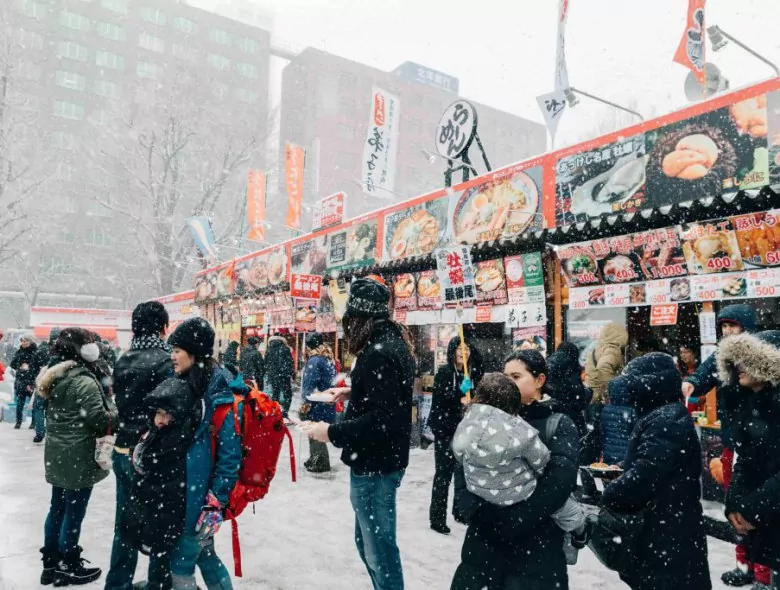
Nowhere does seasons better than Japan. Keep reading to discover the many types of Japanese winter food to make the season extra special!
Japanese food and culture are intertwined, often you can’t have one without the other. There are various Japanese traditional foods embedded into the cultural identity and eating Japanese winter food is a great way to connect to the culture and appreciate the season that many of us are just trying to get through.
Japanese food culture is known across the world for being healthy and aesthetically pleasing, and these delicious seasonal Japanese dishes are no exception.

Nabe (nabemono)
As the leaves start to turn, you can count on hearing about nabe, the cherished Japanese hotpot dish. Nabemono translates to clay pot (nabe) and things (mono) – there are endless varieties of nabe and if you’re alright with straying away from the Japanese traditional foods, you can get experimental too!
Nabe is usually cooked at the dining table whilst everyone is sitting around. It’s a great example of how Japanese food and culture are so intertwined. Eating nabe is a sociable experience, making it a popular home-cooking dish for families o as well as for nabe parties.
Sukiyaki is one of the most popular nabe dishes in Japanese food culture. It’s made with thin slices of beef, as well as tofu, leek, shiitake, hakussai (Chinese cabbage), and shirataki noodles. The ingredients are cooked in a sweet and salty soy sauce broth. It is usually served with a raw egg into which you can dip the ingredients from the hotpot.
Other popular styles of nabe include chanko-nabe, the dish for sumo wrestlers, and shabu-shabu – named after the sound the thin slices of meat make as they cook in the hotpot

Oden
If you’ve been in a convenience store in the cooler months, you’ve probably already come across oden, a traditional Japanese stew. This popular Japanese winter food can easily be found in metal pots next to the cashier at convenience stores, making for a great low-budget meal or snack. Oden is a chance to experience both Japanese food culture and conbini culture. Though it is available in places other than convenience stores too! It is a pick and mix style, so you can select what you put in and then add the broth, which is usually made from stock and soy sauce.
Some things you’ll often find in one of these classic Japanese dishes include daikon, chikuwa (fish cakes), konnyaku (gelatinous triangles made from konjac root), boiled eggs, squid balls, and skewered octopus. It is one of the quintessential Japanese traditional foods, so please do try it!
Curry Udon
Japanese food culture has its fair share of comfort food too. Curry udon is one of many warming Japanese dishes. Thick udon noodles are served in a Japanese curry broth so make the perfect winter meal.
Curry udon often includes some kind of meat, such as beef or pork. It can also contain fried tofu, leeks, mochi, cheese, and tempura.
For two Japanese dishes in one; if you’re enjoying a Golden curry and rice for dinner, curry udon is a wonderful way to use any leftover curry sauce the next day.

Mikan (and kaki)
Who knew that a satsuma could be so delicious? Thanks to Japanese food and culture, the mikan, an easy-peeling sweet and citrusy fruit, is cherished over the winter months. The Japanese New Year celebrations often include Mikan oranges. They are native to China but now Japan is one of the largest mikan producers. You’ll find the tastiest mikan in Shizuoka, Ehime, and Wakayama prefectures, which are all famous for the fruit.
They make a great snack whilst out in the snow, or after visiting an onsen. Mikan is also a popular seasonal flavor in cakes and sweets.
If you like seasonal fruits, kaki (persimmons or Sharon fruit) are closely tied to the winter months in Japanese food and culture, quite literally. You can often find strings of persimmons hanging outside houses to dry. Dried persimmons are delicious but the raw fruit itself is also very tasty and usually one of the cheapest fruits you can find when it’s in season.
Crabs
Winter is the best time to enjoy one of the more luxurious Japanese dishes, crabs. Though you can still buy crab on a lower budget, some snow crabs have been known to sell for incredibly high prices that highlight the richness of Japanese food culture.
The best place to eat crabs is western Japan, where you can taste the fresh crabs from the Sea of Japan. They can be served boiled, raw, in a nabe hotpot, steamed, or even as tempura.

Nikuman
Another popular Japanese winter food that originates from China is the nikuman, a steamed meat bun. The soft and chewy buns are usually made up of finely chopped or minced pork or beef, flavored with scallions, cabbage, shiitake, and ginger.
There are also other less-traditional nikuman flavors, such as pizza (a great vegetarian snack), and anko, one of the Japanese traditional foods, sweet red bean paste.
If you’re in search of cheap Japanese dishes and snacks, nikuman can be found at most convenience stores over winter for a hearty bite into Japanese food and culture at just over 100 yen.
Japanese winter food is rich in both culture and flavor. Beyond this list there are plenty of other foods to enjoy over the winter seasons; tofu, fuyu, oysters, strawberries, zenzai, and much more. Over the new year’s holiday, there are a few Japanese traditional foods and dishes like Toshikoshi soba, Osechi Ryori, and Ozoni that you can try for more of a taste of Japan’s food culture.



